#katsuo of naga-sa
Text
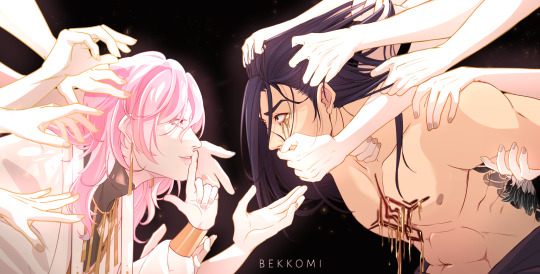
Hush.
92 notes
·
View notes
Text
Rikyū Chanoyu Sho, Book 6 (Part 9): Rikyū’s Hyaku-kai Ki, (1590) Ninth Month, 20th Day; Morning.
9) Ninth Month, 20th Day; Morning [九月廿日・朝]¹.
○ Guests: Mizuno kenmotsu [水野監物]², Takeda Sa-kichi [武田左吉]³.
○ 2-mat room⁴.
○ Unryū-no-kama [雲龍之釜]⁵;
◦ wake-mono mizusashi [〇け物水指]⁶;
◦ Naga-tabi chawan [長旅茶碗]⁷;
◦ Mizu-ken ochaya [水監御茶屋]⁸.
○ Hiroma ni soshite, Hashi-tate no o-cha tate, onaji Hashi-tate dete [廣間ニ而、はしたての御茶立、同はしたて出]⁹.
○ Kushi-awabi [串鮑], namasu [なます], soup (tara, sumashi [たら、すまし]), rice¹⁰.
○ Yaki-mono [焼物] (mana-katsuo [まなかつを])¹¹.
○ Kashi: fu-no-yaki [ふのやき], kuri [栗]¹².
_________________________
◎ This gathering gives us a brief glimpse into Rikyū’s unofficial political duties in his service to Hideyoshi. Here two individuals were meeting with Rikyū -- one, a daimyō and financial officer, on a mission from the Imperial Court; and the other, a samurai, who wished to speak with Rikyū on behalf of his lord (who had fallen out with Hideyoshi during the siege of Odawara, in the summer of that same year).
¹Ku-gatsu niju-nichi・asa [九月廿日・朝].
This gathering is listed out of order in the kaiki (the previous gathering was dated the evening of the 21st day) as it was published in the Rikyū Chanoyu Sho.
²Mizuno kenmotsu [水野監物].
This refers to the daimyō-nobleman Mizuno Moritaka [水野守隆; ? ~ 1598], though the details of his life* are not clear. He seems to have originally served Oda Nobunaga; and at the end of his life Moritaka took the tonsure (perhaps after Hideyoshi's death, perhaps before) and was known as kenmotsu-nyūdō [監物入道]. Following Moritaka, the title kenmotsu seems to have been passed down in his family for several generations.
The general title kenmotsu [監物] refers to an official in the Ministry of Central Affairs (nakatsukasa-sho [中務省]) who functioned as bursar. There were four degrees of kenmotsu (dai [大], chū [中], shō [少], and, sakan [主典] or secretary), ranging from the fifth rank (junior grade) for the dai-kenmotsu, to the seventh court rank (junior grade) for the shō-kenmotsu, the lowest of the four degrees.
On the present occasion, Moritaka may have been at Juraku-tei to discuss financial matters relevant to the planned invasion of the continent with Hideyoshi, on behalf of the Imperial Court.
__________
*Including his precise court title and rank.
³Takeda Sa-kichi [武田左吉].
Takeda Sa-kichi [武田左吉; dates unknown] was a samurai and, at the time of this chakai, an important retainer of Oda Nobukatsu [織田信雄; 1558 ~ 1630], the second son of Oda Nobunaga.
After Nobunaga's death, Nobukatsu became estranged from Hideyoshi (because Hideyoshi passed over his candidacy to assume the headship of the Oda clan in favor of Oda Hide-nobu, the infant son of Nobunaga’s oldest son Nobutada -- who had died at the Honno-ji along with his father), and formed an allegiance with Tokugawa Ieyasu to oppose Hideyoshi; but in 1584 Hideyoshi made peace with Nobukatsu, and Nobukatsu in effect became one of Hideyoshi’s retainers. Yet during the siege of Odawara, Nobukatsu once again fell out with Hideyoshi (and, as a result, was placed under house-arrest -- supervised by Hideyoshi's agents -- and forced to shave his head and become a monk).
It is likely that Takeda Sa-kichi’s presence at the Juraku-tei was directly related to this developing situation: as this gathering was held not even two months after the culmination of the siege of Odawara, Sa-kichi was probably acting as a liaison between Nobukatsu and Hideyoshi; and perhaps meeting with Rikyū to ask him to intercede with Hideyoshi on his lord’s behalf.
⁴Ni-jō shiki [二疊敷].

⁵Unryū-no-kama [雲龍之釜].

The kama was suspended over the ro on a bamboo jizai, probably so that the mouth of the kama was 6- or 7-bu lower than the top of the ro-buchi.
⁶Wake-mono mizusashi [〇け物水指].

⁷Naga-tabi chawan [長旅茶碗].
The few references to this chawan in the tea records of the day stop around the time of Rikyū’s death*, and since Rikyū only mentions this bowl by name in his kaiki, there is no way to even know whether it was a red or black raku bowl (from the evidence provided by his kaiki). In the Sōtan Nikki [宗湛日記] (the diary of Kamiya Sōtan [神谷宗湛; 1551 ~ 1635]), however, Sōtan notes that he attended a gathering at midday on the same day as the present gathering was held, at which a “kuro-chawan” [黒茶碗] was used. And in Rikyū‘s entry describing the gathering for Sōtan, he again states that the chawan was Naga-tabi. So it appears from this corroborating evidence that Naga-tabi was, indeed, a black bowl.
Rikyū did not usually give his utensils names -- except when a very significant event or happenstance was connected with the piece. Naga-tabi [長旅], as a word, means a “long journey.” Rikyū is mentioned as using a kuro-chawan for the first time (this reference is also found in the aforementioned Sōtan Nikki) during the summer of 1587, in Hideyoshi’s temporary complex on the grounds of the Hako-zaki Jinja [箱崎神社] (near the city of Fukuoka [福岡]), during his conquest of Kyūshū. If Rikyū indeed carried that same kuro-chawan from Kyōto, around Kyūshū, and then brought it back to Ōsaka and Kyōto with him, such a bowl would certainly be deserving of the name Naga-tabi. Should that have been the case (and this is all conjecture on my part), then the bowl would have been an example of the earlier type of black bowls that Chōjirō made, a style (characterized by nearly vertical sides, and a square profile) represented by the Kitano kuro chawan [北野黒茶碗], shown below (which Rikyū first used -- as a brand new chawan -- at the Kitano Ō-cha-no-e [北野大茶の會], just over two months later that same year).

Be that as it may, as the Naga-tabi chawan [長旅茶碗] is no longer known to exist (at least under that name), there are no photographs of it. Nevertheless, the kuro-chawan shown above may resemble the bowl -- if it really dated from Chōjirō’s earlier period‡.
___________
*There is a story that, on the day of his death, after serving tea to Hideyoshi -- who appeared at Rikyū’s house (according to one account, in order to remonstrate with Rikyū, and try to persuade him to change his mind, apologize to Hideyoshi publicly, and thus avoid the necessity of committing seppuku) -- Rikyū broke the chawan, so it would not be used again (some say because he felt that Hideyoshi’s dishonorable talk on this morning had polluted it beyond salvage).
While some say that the chawan he used was one of the pair known as O-guro [オ・グロ] and Ō-guro [オーグロ], it being one of these clearly would invalidate this story, since both of these chawan survived into the early modern period (and one, the smaller one, is still extant today).
If, however, the chawan he used that day was actually the Naga-tabi [長旅] bowl, then the story might be true, and this would account for the disappearance of the chawan around that time. It is important to note that Rikyū did not write down the details of this final chakai (since he would have had no reason to need a record of it); so what we know is mostly based on hearsay (the only other person present on that day was the Honkaku-bō, and it is to him that the story of Hideyoshi’s visit is ascribed).
†Bowls with a freer shape, and occasional rust colored blushes -- such as seen in the Honkaku-bō chawan (below) -- did not appear until the last months of Rikyū’s lifetime.
‡However, there is also a kuro-chawan known as the Honkaku-bō chawan [本覺坊茶碗], and it is possible that Rikyū gave the chawan that he used at his last chanoyu to that monk afterward, in thanks for his services (Honkaku-bō took over the duties of steward to Rikyū’s Sakai household after the house was moved to Mozuno, since the distance from the Nanshū-ji made it difficult for Nambō Sōkei to continue in this post). Of course it might also be possible that the Honkaku-bō simply took the bowl (as a memento of Rikyū) in the confusion that would have filled the household as the hour for Rikyū’s seppuku approached.

At any rate, if one of these latter scenarios is true, and if the bowl that Rikyū used on that occasion was the Naga-tabi chawan, then it could also be the case that Naga-tabi was simply renamed Honkaku-bō chawan after it passed out of Rikyū’s hands -- a practice, by the way, that was still fairly common at that time. The bowl known as the Honkaku-bō chawan is shown above.
Nevertheless, it must be added that the more eccentrically shaped bowls are better associated with Sōtan and his period, rather than with Rikyū -- and the kuro-chawan shown above is transitional, and so could be associated with either. (Even the maker of these early bowls is hardly certain, with the name Chōjirō being associated with at least two, and possibly even three, different potters who were using the same kiln at the same time. Only starting from the early Edo period is there a good degree of certainty about who made which pieces.)
⁸Mizu-ken ochaya [水監御茶屋].
This line was miscopied at some point in time, and, as it stands, is nonsensical.
The original (as found in other sources for this kaiki) reads Mizu-ken no o-cha nari [水監の御茶也]* -- meaning that the tea used at this gathering was from Mizuno Moritaka (Mizuno kenmotsu), one of the guests at this gathering. In other words, Rikyū received a sa-tsū-bako† containing a container of tea as a gift -- the word “Mizu-ken” [水監] being a sort of abbreviation of his name‡.
The tea would have been contained in a lacquered chaki (probably a ko-natsume, such as that shown below, which would hold enough tea to serve two people with both koicha and usucha, or three people with koicha only**), tied in a fukusa-sized furoshiki, and sealed†† inside a wooden box. Since this was all quite standard practice, no mention of the chaki (or even that a sa-tsū-bako was used) would have been necessary.

When using a natsume, Rikyū used a chashaku with a slight bend at the node, such as shown in the photo below. This would insure that the chashaku contacted the lid in two places, thus keeping it it from moving or rotating when the hand released it on the rounded lid of this kind of tea container.

And as for the other things that are necessary for the service of tea, these would have been utilitarian -- a take-wa, and probably a mentsū.

__________
*The kanji for nari [也] is also pronounced ya. Someone probably transcribed this statement phonetically [オチャヤ], and another person wrote it again in kanji, interpreting o-cha-ya [お茶や] to be o-chaya [御茶屋], a teahouse (in the Edo sense of the word).
This is an example of how misunderstandings -- both in the minds of chajin, and in the popular imagination as well -- arose from these kinds of misrepresentations.
†As Mizuno Moritaka was a court official, and probably visiting Juraku-tei in his official capacity (for talks with Hideyoshi regarding the part that the court would be expected to play in the financing of his upcoming invasion of the continent), this was probably a complementary gift that Moritaka brought to Rikyu on behalf of the Imperial Court (perhaps with a polite request that Rikyū use his influence to try to decrease the financial burden that the invasion would place on the imperial coffers). Probably it contained matcha that had been ground from the tea in one of the Imperial cha-tsubo.
No mention is made of the tea container in the kaiki that was published in the Rikyū Chaonyu Sho, since this chaki was provided by Moritaka rather than prepared by Rikyū, but by convention it was usually a natsume or fubuki-nakatsugi. (However, since Rikyū used a nakatsugi when serving tea to Kamiya Sōtan immediately after this gathering had ended, a natsume seems more likely -- since to reuse a nakatsugi might make it seem like Rikyū was serving Sōtan with the left-overs.)
The modern-day sa-tsū-bako temae is a travesty of the original practice. In Rikyū's period, the box contained only the gift tea -- sa-tsū-bako [茶通箱] boxes came in three sizes (which could hold one, two, or three containers of matcha), though it was actually very rare for the gift box to contain more than one kind of tea, almost always tea suitable for use as koicha. Indeed, this entry can be taken as a “case study” of how the sa-tsū-bako was used in his time.
The different types of boxes in which chaire (and later other utensils as well) are kept -- zan-buta [棧蓋], shi-hō-zan-buta [四方棧蓋] and ya-rō-buta [藥籠蓋] -- were patterned on the three types of boxes made as sa-tsū-bako (and the idea to keep chaire, and then other utensils, in such boxes arose from the matter of what to do with the left-over sa-tsū-bako: wabi teamen began by using these boxes to store their own chaire, and the idea caught on -- with people ordering such boxes especially to use as storage containers for their utensils).
‡In the same way, Rikyū and his contemporaries usually referred to Furuta Oribe [古田織部] as Ko-ori [古織] -- using the first kanji from each part of his name and title.
**It seems most likely that he transferred all of the matcha into the chawan (since if he saved some, that tea would have been wasted, since it could not be served as koicha if it were used later), and then made one bowl of koicha which was passed around. Since Rikyū was the intended recipient of the gift tea, the guests would have made sure to leave enough for him, so that he could appreciate the tea fully.
This may also be the reason that Rikyū decided to serve the guests usucha later, in the hiroma -- using the tea that he had originally prepared for the gathering.
††While originally the box was sealed by pasting a paper tape around the place where the lid joins the body of the box, after Hideyoshi's objection to knives in the tearoom, people began to think of alternative ways to keep the box closed (if not actually sealed). One way was by using tying cords, which eventually came to be attached to the sides of the box (to save cordage). So, by 1590, the box was just as likely to be tied shut with cords. as to be actually sealed with a paper tape.
⁹Hiroma ni soshite, Hashi-tate no o-cha tate, onaji Hashi-tate dete [廣間ニ而、はしたての御茶立、同はしたて出].
The large reception room, or hiroma [廣間] (which means large room), in Rikyū’s residence within Hideyoshi’s Juraku-tei complex, which was of 18 mats, adjoined the 2-mat room through the katte.
After having the kaiseki and then the gift koicha in the small room, the guests would have proceeded through the katte into the large room, where they would have been served usucha* (using tea from Rikyū's own jar).
Rikyū does not describe the utensils that he used to serve tea in the hiroma.
__________
*It is possible that they were also served a koicha in the hiroma, but not likely (since no additional kashi are mentioned); and doing so would have prolonged the gathering excessively. (The kuchi-kiri gathering which Rikyū hosted for Hideyoshi on the 13th day of the same month is a good example of what has to be done if two distinct koicha-seki are going to be held during the same chakai.)
¹⁰Kushi-awabi, namasu, shiru (tara-sumashi), meshi [串鮑、なます、汁 ・ たらすまし、めし].
Kushi-awabi [串鮑] dried abalone, usually it was reconstituted by being boiled in broth. See footnote 13 in the post entitled Rikyū Chanoyu Sho, Book 6 (Part 1): Rikyū’s Hyaku-kai Ki, (1590) Eighth Month, 17th Day (the first post in this series of translations from Book 6 of the Rikyū Chanoyu Sho).
Namasu [鱠] is a sort of salad made of slivered raw daikon and carrot, dressed with a sweet vinegar sauce.
Tara sumashi [鱈清汁] means a clear soup made from the codfish (tara [鱈], Gadus macrocephalus). In addition to cod, the soup would usually contain a few pieces of some aromatic plants (leeks or ao-negi, and/or enoki mushrooms), and a small piece of yuzu peel.
Note that while miso-shiru is de rigueur as the first course at modern-day chaji, it was served only occasionally in Rikyū’s period -- and, it seems, usually only when something else (that was “more interesting”) was not available.
¹¹Yaki-mono ・ mana-katsuo [焼物 ・ まなかつを].
Mana-gatsuo [まながつほ] seems to be a variety (mana [眞] means “true” or “real”) of katsuo (oceanic bonito, or slapjack tuna). See footnote 13 in the post entitled Rikyū Chanoyu Sho, Book 6 (Part 2): Rikyū’s Hyaku-kai Ki, (1590) Eighth Month, 18th Day, Morning for additional details.
¹²Kashi ・ fu-no-yaki, kuri [菓子 ・ ふのやき、栗].
Fu-no-yaki [麩の焼], one of Rikyū’s most popular home-made kashi, are little crêpes filled with sweet red-bean paste.
Kuri [栗], chestnuts, probably means yaki-guri [焼栗], roast chestnuts.
1 note
·
View note
Text



Mostly an excuse to draw these guys being gay again and a demon contractor's hair in my oc's universe ;;w;;/
#katsuo of naga-sa#clyde n sprigford#ocs#bekkodraws#artists on tumblr#also i just wanted to see if i can take flatting and rendering clyde's scars over and over
24 notes
·
View notes
Text
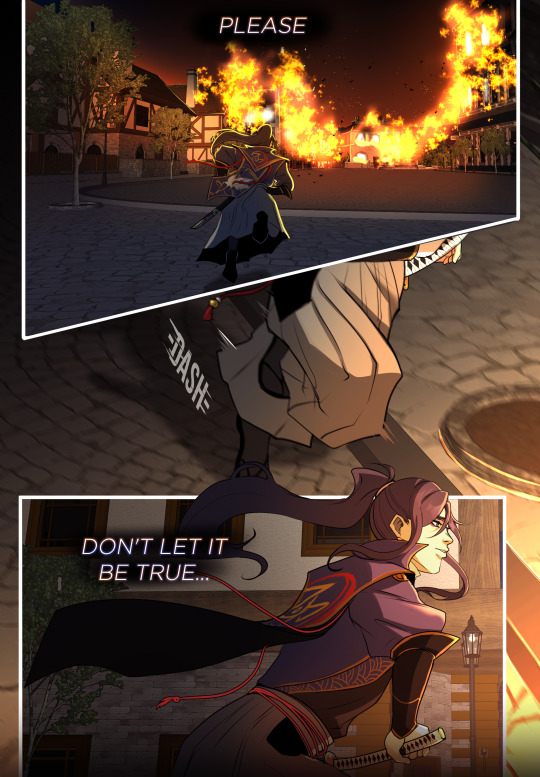
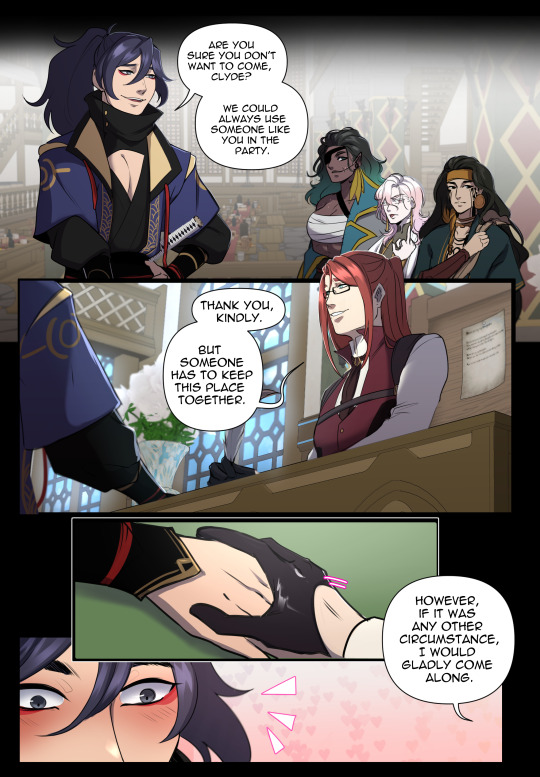

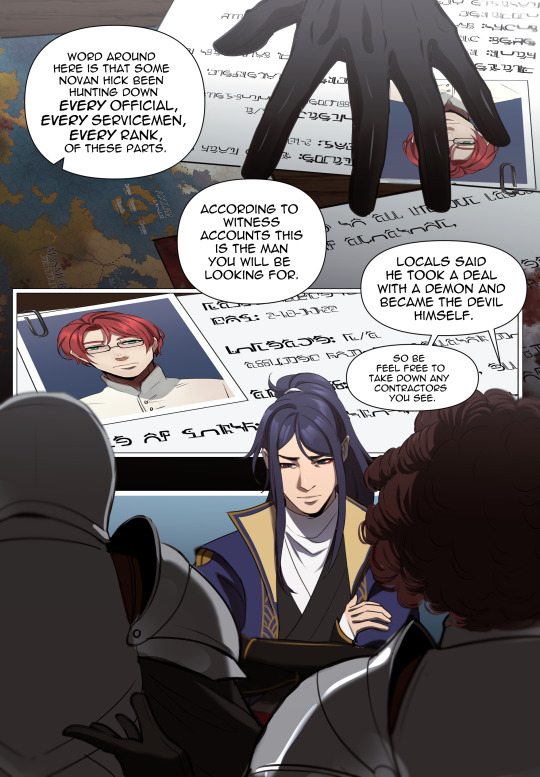
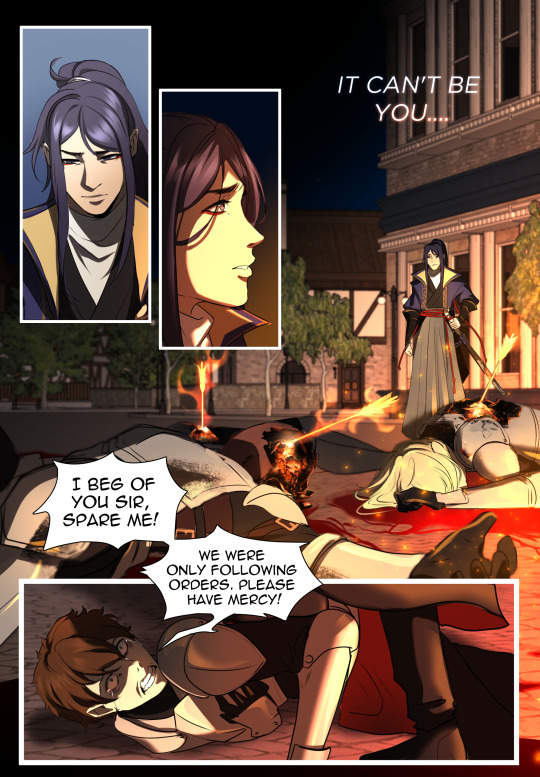



OC comic I did for my one and only OC-tober post. Finally get to see how it would look like in a longer format.
#OC-tober#OCs#Clyde N Sprigford#Katsuo of Naga-Sa#comic#one day i will draw more random moments of their stranger to friends to enemies to friends to lovers arc#bekkodraws#Ennis Ettvald
32 notes
·
View notes
Text



More of these two I drew prior to the comic! It was mostly to get the brainworms out over them before I started redesigning.
#katsuo of naga-sa#clyde n sprigford#ocs#them gay bitches growing old together#artists on tumblr#bekkodraws
24 notes
·
View notes
Text

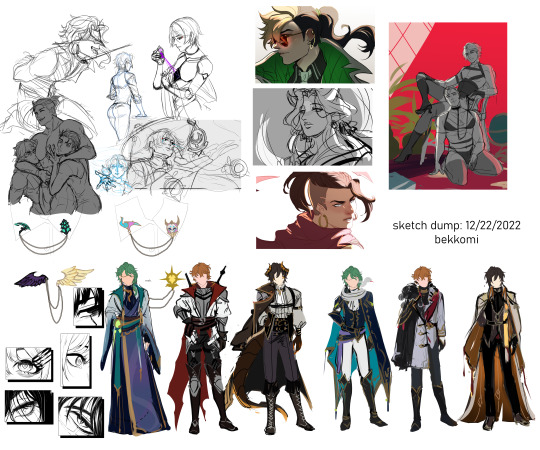
Sketch dump for the end of the year!
#sketch dump#ocs#katsuo of naga sa#clyde n sprigford#tessa swiftgold#selene#vincent mirza vermont#yeah im not tagging everyone#zhongli#baizhu#childe#bekkodraws
56 notes
·
View notes
Text

I first drew this man in 2015 and it only took me till the end of this year to bother designing his back tat properly
32 notes
·
View notes
Text

Slowly trying to get back into backgrounds but i still suck lol
17 notes
·
View notes